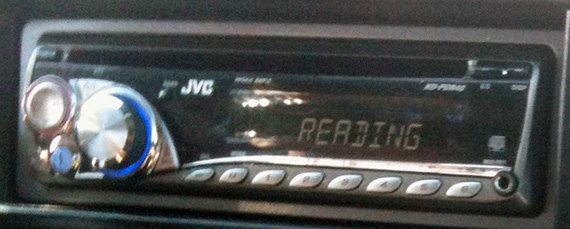Apple's iPad - The AnandTech Review
by Anand Lal Shimpi, Brian Klug & Vivek Gowri on April 7, 2010 9:39 PM EST- Posted in
- Smartphones
- Mac
- Apple
- iPad
- Mobile
USB Charging
There's been a lot of discussion about the iPad's ability (or lack thereof) to charge from most USB power sources. Even among accessories, the compatibility situation ranges from relatively to completely uncertain.
Let's start from the beginning though - it isn't like you're going to be unable to charge the thing. The iPad ships with a beefy 10.71 watt (5.1 volt, 2.1 amp) USB power supply and a heartier-than-normal feeling USB dock cable. Given the device's relatively long battery life (as we've already demonstrated), it isn't like charging is going to be something you'll do more than once a day. But Apple has left the charging situation uncharacteristically vague.
We tested charging with a number of dock connector charger accessories we had, and found the state of things confusing. Let's start with the good; Apple's ultracompact USB power adapter, the one shipped with the iPhone 3G and 3GS, does charge the iPad. If you've still got any laying around, the older, larger iPod chargers that have USB charging circuitry also work. Interestingly, both of these power adapters are only rated at 5 watts.
Support for charging from accessories from 3rd parties, however, varies wildly: devices that support firewire-only charging definitely won't work - the iPad lacks that circuitry the same as iPhones and iPod Touches. Other adapters that lack Apple-specific charging circuitry also don't work. Third party battery packs also won't charge the iPad.
Car chargers are a mixed bag - Griffin's PowerJolt SE car charger, sold at the Apple Store, doesn't charge the iPad at all. However, Belkin's Micro Auto Charger (rated at 5 watts), also sold at the Apple Store, does charge. Interestingly, the Griffin has a hard connected dock connector, while the Belkin has a USB termination and aftermarket dock cable - it's likely that the iPad favors USB-based chargers rated at or above 5 watts.

The iPad is picky about its power - it's something of a connoisseur
On the desktop side, charging is even more of a mixed bag. If you've got a PC, you're probably out of luck unless motherboard supports the USB charging specification. Remember that USB 2.0 by default supports 500 mA of current at 5 volts for a maximum of 2.5 watts. From what we've seen so far, at least 5 watts is required for the iPad to charge. Newer USB ports that support the battery charging specification can supply up to 1.5 amps at 5 volts, for a maximum of 7.5 watts. From what we've seen, it's likely that 5 watts is the requirement for USB charging to work properly. Apple's iPad charging knowledge base document mentions that a "high-power USB port" is required for charging, but neglects to enumerate what computers support the standard, or what standard they're calling high-power. Apple notes that "many recent Mac computers" support the high-power USB port charging standard, and that "most PCs or older Mac computers" will charge the iPad when it's in sleep mode.
We tested with a MacBook Pro 2,1 (pre-unibody Core 2 Duo), Mac Pro 4,1 (Nehalem), Latitude XT, and desktop with an EVGA X58 SLI - none of them charged the iPad over USB while powered on or in standby. It's a step backwards that the iPad discharges while syncing, and keep discharging if you leave it plugged into a non-supported USB port. Remember to plug it back into its special beefy power supply, or you'll likely be left without a working iPad.
The iPad a Super Head Unit is Not
Unfortunately, it looks like the dock connector circuitry on the iPad does not support car head units. We tested with a JVC KD-PDR40 and an Alpine iDA-X001 (which Alpine touts was designed in part with Apple to emulate the iPod interface), and both resulted in the following notification on the iPad:

Bad news for people with aftermarket head units
The Alpine iDA-X001 showed the following:

While the JVC KD-PDR40 constantly reported "reading" as its status:

It seems that, for whatever reason, the iPod playback hardware and software playback paths are not present on the iPad. This is disappointing, especially considering the number of car enthusiasts hoping to use the iPad as a super-sized head unit. In fact, much of the initial speculation was that vehicle integration would be part of the iPad's secret sauce. Based on these results, that obviously was never the intention.










108 Comments
View All Comments
solipsism - Thursday, April 8, 2010 - link
I also thought the Moorestown recommendation was odd, especially when the next page was about the phenomenal battery life. If he made a more detailed case for it perhaps he'd have a point, but the simple "because it's faster" stance is lacking.Anand Lal Shimpi - Thursday, April 8, 2010 - link
Initial power specs for Moorestown appear to be fairly competitive with ARM based SoCs. Remember this is Moorestown, and not Pineview. The two chips are very different.Realistically I don't think it would be Moorestown, but the 32nm follow-on starts to make a lot of sense.
Take care,
Anand
metafor - Thursday, April 8, 2010 - link
Just curious, what are the initial power numbers for Moorestown anyway? Keep in mind that with the change in bus architecture and the use of LP DRAM, performance will be significantly slower in some cases than current netbooks. Also, would it really compare to an A9-class SoC?IntelUser2000 - Friday, April 9, 2010 - link
I have a feeling Apple didn't go Moorestown for two primary reasons.1) Timeframe
2) Cost
Moorestown should be announced shortly, but the devices based on it won't be available until Q3 of this year. That's 6+ months from when the iPad is going to release. And although Intel might achieve both better performance and comparable power usage, but the sacrifice there will be higher cost. Fully integrated SoC like the A4 costs significantly less.
Performance should be quite good. There's a 600MHz version for smartphones that can use Burst Mode to 1.2GHz, and a MID oriented version that probably clocks at 1.3GHz base and does 1.9GHz burst. It's supposed to feature "Bus Turbo" as well.
If they also do a full integrated memory controller unlike Pineview we have a good chance it'll be clock per clock faster than Netbook Atoms. Earlier on Intel claimed "30%" boost over previous platform but clock speeds weren't mentioned.
metafor - Friday, April 9, 2010 - link
Moorestown will be a fully interated SoC. It'll have LP DDR1 and LP DDR2 memory controllers as well as a GPU, the Atom CPU and various peripheral connectivity. It's comparable to the A4 in terms of features although I really would not write it off as "comparable" in terms of power until some data is published.ekul - Thursday, April 8, 2010 - link
I'd agree the successor to moorestown is more promising. Are there even any shipping products based on moorestown yet? I don't think apple is going to take a gamble on an untested platform.I'm genuinely looking forward to seeing performance numbers for cortex a9, especially since there will be real dual core mobile variants, not just hyperthreading. A technique like what MS is planning for IE9, rendering a website on one core and compiling javascript on another, would help bridge the perormance gap along with the higher clocks.
michal1980 - Wednesday, April 7, 2010 - link
really this is easier then a laptop/notebook?A notebook by its vary nature I can rest on my lap or a table and adjust its screen. To watch a movie I dont have to hold the thing up.
To type, I dont have to bend to werid angles to hold the device up, etc etc.
IMHO, it seems like alot of the experance is attributed to the newness of the device vs its actual usage. I'm wonder how this newness will wear.
manicfreak - Thursday, April 8, 2010 - link
Can't you do all of those aforementioned things on an ipod touch/iphone? There are already home automation apps for the iphone right now.What can the iPad do that the iphone/ipod touch can't? Beside having a bigger screen and longer battery life?
And for such a big device, the performance should be closer to an atom instead of a snapdragon.
If something doesn't fit in my pocket, then I would rather bring a light-weight CULV laptop with me... with touchscreen if one wishes (i.e. Acer Timeline 1820T) or a hybrid notebook-tablet (Lenovo IdeaPad U1).
jasperjones - Thursday, April 8, 2010 - link
"there are some things the iPad does much better than anything you might own today. Web browsing, photo viewing, reading email, any passive usage scenarios where you're primarily clicking on things and getting feedback, the iPad excels at."What exactly makes it better at those tasks? It's not that I disagree but, in my opinion, you didn't drive this point home. I don't understand why you think it's better. And yes, I read the whole article.
solipsism - Thursday, April 8, 2010 - link
I don't think anything anyone can write can convince you. Many aspects just feel more natural to use. That isn't to say it's perfect everywhere but I think that as a casual mobile consumption device it's much better than a notebook, and much better than a netbook.